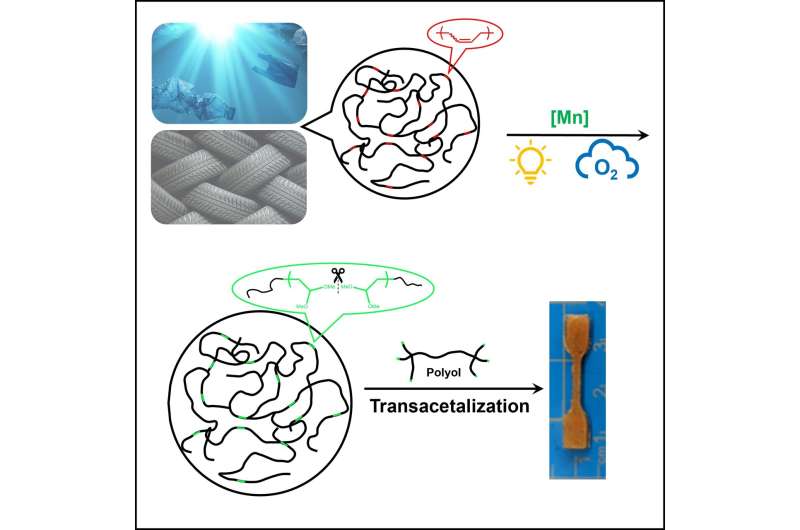This article has been reviewed according to Science X's editorial process and policies. Editors have highlighted the following attributes while ensuring the content's credibility:
fact-checked
peer-reviewed publication
trusted source
proofread
Innovative method uses oxygen and light to recycle unsaturated polymers

A study published in Cell Reports Physical Science showcases a novel method for the recycling of unsaturated polymers such as rubber and plastics.
The paper, authored by Dr. Junpeng Wang, assistant professor of polymer science at The University of Akron, and a team of current and former students including Dr. Hanlin Chen '23, Dr. Devavrat Sathe '23, Xin Guan and Puyang Zhang, introduces a process using oxygen and light to help break down the polymers naturally.
Since the 1950s, the mass production of plastics has resulted in the creation of approximately 8.3 billion metric tons of polymers. Unfortunately, the majority of these polymers have been discarded or incinerated, leading to significant environmental contamination.
Only 600 million metric tons have been effectively recycled. The stability and durability of commercial polymers, particularly polyolefins, which constitute over half of global polymer production, present significant recycling challenges due to their hydrocarbon backbone.
The new research focuses on introducing unsaturation to enhance the reactivity of these polymers, thus facilitating their recycling. Traditional methods for oxidative cleavage of alkenes, such as ozonolysis, epoxidation, and permanganate oxidation, while effective, often require environmentally unfriendly, energy-intensive conditions that are difficult to scale up. These methods also generate unwanted by-products, posing additional environmental challenges.
In contrast, the ideal oxidant for such processes would be O2, due to its abundance, green nature, and accessibility. However, previous methods using O2 for polymer degradation have been slow and not well controlled for recycling purposes.
This study pioneers a controlled, efficient method for breakdown using a catalyst that, when activated under light, successfully breaks down the polymers at room temperature without requiring elevated temperatures or pressures.
Wang and his team's work opens new avenues for the recycling of polymers, addressing one of the most pressing environmental issues of our time. This research not only enhances our understanding of polymer degradation but also provides a practical, scalable solution for recycling unsaturated polymers.
More information: Hanlin Chen et al, Deconstruction of unsaturated polymers through photo-mediated oxidation under O2, Cell Reports Physical Science (2024). DOI: 10.1016/j.xcrp.2024.102104
Journal information: Cell Reports Physical Science
Provided by University of Akron





















